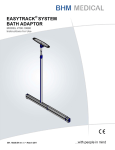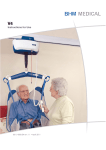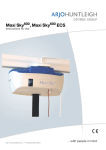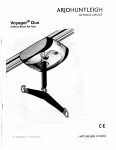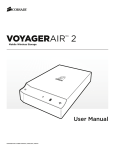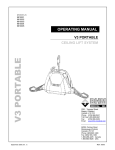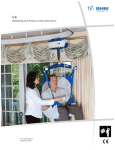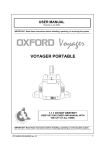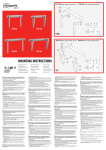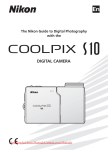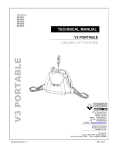Download BHM V5 Voyager Duo User Manual
Transcript
Voyager Duo Instructions for Use 001.19520.EN rev.1 December 2009 Printed in Canada BHM Medical Inc. reserves the right to change or discontinue any specifications, design, features, model or accessories shown without notice. TM Trade-mark of BHM Medical Inc. All rights reserved. © BHM Medical Inc., 2009 The content of this publication may not be copied either whole or in part without the consent of BHM Medical.Printed in Canada Table of Contents General Information ............................................................................................... 5 Foreword ......................................................................................................... 5 Service and support ...................................................................................... 5 Manufacturer Information ............................................................................ 6 Authorized European Representative ........................................................... 6 Definitions Used in this Manual ................................................................... 6 Intended Use ................................................................................................. 6 Operational Life ........................................................................................... 6 Equipment Identification .............................................................................. 7 Verifying the Package Contents ................................................................... 7 How to Use this Manual ............................................................................... 7 Symbols Used ................................................................................................. 8 Safety Instructions................................................................................................... 9 General Instructions ........................................................................................ 9 Safe Working Load ...................................................................................... 9 Important Safety Directions ......................................................................... 10 Shock Prevention .......................................................................................... 10 Fire and Explosion Prevention ..................................................................... 11 Human and Environmental Safety Practices ................................................ 11 Battery and Battery Charger Safety Practices ................................................. 11 Equipment Warning Labels .......................................................................... 11 Part Designation ...................................................................................................... 12 Hand control .................................................................................................... 13 Charger ............................................................................................................ 13 Slings......................................................................................................................... 14 How to Use the Voyager Duo.................................................................................. 15 Return to Charge (RTC) ............................................................................... 16 Emergency Stop (red cord) .......................................................................... 16 Emergency Lowering ................................................................................... 16 Emergency Brake ......................................................................................... 16 Battery Information ......................................................................................... 18 Indicator Lights ............................................................................................ 18 Charging the Batteries .................................................................................. 18 Using the FIDO Function (Pre-Programmed Positions) ................................. 20 Use of Slings ................................................................................................... 20 Spreader Bars and Stretcher Frame .............................................................. 20 Slings ............................................................................................................ 20 Before Approaching the Patient ................................................................... 20 Programming the Ceiling Lift ......................................................................... 20 Changing the Speed of Movement ............................................................... 21 3 Table of Contents Voyager Duo Programming.................................................................................... 21 Adjusting the Spreader Bar Height .............................................................. 22 Enable/Disable Return to Charge (RTC) ..................................................... 23 Care and Maintenance ............................................................................................ 24 Preventive Maintenance Schedule .................................................................. 24 User Inspections .............................................................................................. 24 Inspections by an Authorized Service Technician .......................................... 25 Daily Checklist ................................................................................................ 27 Inspection and Cleaning ............................................................................... 27 Strap Inspection ............................................................................................ 27 Handling and Storage ...................................................................................... 28 Battery Replacement .................................................................................... 28 Verification of the Charger’s Power Source ................................................ 28 Sling Inspection ............................................................................................ 28 Annual Inspection ........................................................................................... 28 Maintenance Requirements .......................................................................... 28 Troubleshooting....................................................................................................... 29 Labels on the Lift..................................................................................................... 31 Technical Specifications.......................................................................................... 32 Lift Dimensions ........................................................................................................ 34 Electromagnetic Compatibility .............................................................................. 35 Electromagnetic Compliance .......................................................................... 35 Electromagnetic Emissions ............................................................................. 35 Electromagnetic Immunity .............................................................................. 36 Limited Warranty ................................................................................................... 39 4 General Information Thank you for purchasing the BHM Voyager Duo ceiling lift. Your Voyager Duo is part of a series of quality products designed specially for home care, nursing homes and other health care uses. We are dedicated to serving your needs and providing the best products available along with training that will bring your staff maximum benefits from every BHM Medical product. Please read this manual thoroughly and contact us if you have any questions about the operation or maintenance of your BHM Medical equipment. Foreword Please read this manual in its entirety before using your Voyager Duo. The information in this manual is crucial to the proper operation and maintenance of the equipment and will help protect your product as well as ensure that the equipment performs to your satisfaction. Lifting and transferring a person always presents a potential risk. Some of the information in this manual is important for your safety and must be read and understood to help prevent injuries. BHM Medical strongly advises and warns that to avoid injuries that can be attributed to the use of inadequate parts, only parts designated by BHM Medical should be used on equipment and other appliances supplied by BHM Medical. Furthermore, unauthorized modifications on any BHM Medical equipment may affect its safety. BHM Medical will not be held responsible for any accidents, incidents or deficiencies of performance that occur as a result of any unauthorized modification to its products. Tested according to standards by: Product Service and Service and support A service routine must be performed on your Voyager Duo by BHM Medical certified service personnel. This will ensure the safety and good functioning of your product. See section called “Care and Maintenance” in this manual. If you require further information, please contact your local BHM Medical representative which can offer comprehensive support and service programs to maximize the long-term reliability, safety and value of the product. Contact your local BHM Medical representative for replacement parts. Additional copies of this manual can be purchased from your local BHM Medical representative. When ordering, include the Instructions for Use product number (see front page) and equipment identification number. 5 General Information Manufacturer Information Operational Life This product has been manufactured by: BHM Medical Inc. 2001 Tanguay Street Magog (Quebec) Canada J1X 5Y5 The equipment is designed and tested for a useful life of seven (7) years or 10,000 transfers—whichever comes first—subject to preventative maintenance as specified in the “Care and Maintenance” section in this manual. Time equivalence between the number of transfers versus the number of years is made clear in the table in Fig. 1. Authorized European Representative Huntleigh Healthcare Ltd. 310-312 Dallow rd. Luton, UK LU1 1TD Years Definitions Used in this Manual WARNING: Transfers per Day (10,000 transfers) 4 7 6 4.5 8 3.5 Fig. 1 Means: Failure to understand and follow these instructions may result in injury to yourself and others. WARNING: The manufacturer cannot ensure full safety for a ceiling lift or an accessory of which the life span has been exceeded. CAUTION: The red indicator light on the ceiling lift will blink when it is about halfway to its useful life, and again to indicate the end of the useful life period. Means: Failure to follow these instructions may cause damage to the product. Intended Use The operating life of this equipment corresponds directly to the safe operating time period before a complete overhaul is required. Aging of the cassette, frequency of use (transfers per day), the weight of the patient and maintenance frequency are factors that have an impact on the Voyager Duo’s life span. A transfer is defined as the displacement of a patient from one point to another. A transfer cycle includes a lifting and a descending action. The Voyager Duo is designed for lifting patients in a homecare setting, at nursing homes and other assisted living centers. Patient transferring is performed under the supervision of an appropriately trained caregiver staff in accordance with the instructions outlined in this manual. All other uses must be avoided. The expected operational life for fabric slings and fabric stretchers is approximately 2 years from date of purchase. This life expectancy only applies if the slings and stretchers have been cleaned, maintained and inspected in accordance with the BHM Medical Sling Application Guide, the Instructions for Use and the “Preventive Maintenance Schedule”. The equipment must only be used for the purposes stated above, and must be installed by BHM Medical authorized personnel and in accordance with local codes. The expected life for other consumable products, such as batteries, fuses, lamps, straps and cords is dependent upon the care and usage of the equipment NOTE: Means: This is important information regarding the correct use of the equipment. 6 General Information concerned. Consumables must be maintained in accordance with published Instructions for Use and the “Preventive Maintenance Schedule”. Equipment Identification The unit's identification number (specification, model, serial number) appears on a silver nameplate attached to the lift’s plastic housing. Verifying the Package Contents Always ensure that the ceiling lift will be installed by a contractor or installer that has been authorized by BHM Medical. Upon receipt of the equipment, verify it against the packing list to ensure it is complete and inspect the equipment for possible damage due to shipping. If there is any damage, notify the carrier immediately to file a claim. Provide complete information concerning damage claims or shipping errors to your local BHM Medical representative. Include all equipment identification numbers and group part numbers (if any) as described above along with a full description of damaged parts. How to Use this Manual WARNING: Do not attempt to use this equipment without fully understanding the information contained in this manual. To ensure the safe operation of the Voyager Duo, read the entire manual carefully, especially the “Safety Instructions” section, before installing, operating, or servicing this equipment. If anything is not completely understood, please contact your local BHM Medical representative for more details. Failure to comply with warnings in this manual may result in injuries. Keep this manual with the lift and refer to it as required. Make sure that all operators are regularly trained in the use of the equipment according to the information found therein. 7 General Information Symbols Used Symbols Key to symbols This symbol is accompanied by the name and the address of the authorized representative in the European Community. This symbol is accompanied by a date to indicate the date of manufacture and by the address of the manufacturer. This symbol indicates that the product complies with the medical device directive 93/42/EEC. This symbol is accompanied by the manufacturer's catalogue number. This symbol is accompanied by the manufacturer's serial number. This symbol indicates “separate collection” for all batteries and accumulators as per the WEEE Directive. This symbol refers to the Instructions for Use. This symbol indicates a class II electrical equipment: term referring to electrical equipment in which protection against electric shock does not rely on basic insulation only. This symbol indicates a type BF applied part. This symbol indicates a risk of pinching. This symbol locates the emergency stop system on the lift. This symbol locates the emergency lowering system on the lift. Fig. 2 8 Safety Instructions The equipment must be used in accordance with these safety instructions. Anyone using the equipment must also have read and understood the instructions in this manual. General Instructions Keep these Safety Instructions with the ceiling lift at all times. Read the Instructions for Use in this manual before installing, operating, or servicing this equipment. WARNING: The Voyager Duo is for transferring patients only. Do not use the lift for any other purpose. If there is anything you are not sure about, contact your local BHM Medical representative. WARNING: Always place the sling around the patient according to the instructions found in the Loop Slings Instructions for Use that comes with the sling. Failure to do so may result in injuries to you or to others. CAUTION: Do not drop either the ceiling lift cassette or the batteries, since they may cause internal damage that is not easily seen. If the ceiling lift is suspected to be damaged, contact your local BHM Medical representative for servicing. Safe Working Load The Voyager Duo has been designed with two settings with regards to the safe working load: • 100 kg (220 lb): Safe working load adjusted in factory • 200 kg (440 lb): Maximum capacity of the lift This setting has already been determined by the BHM Medical installation team in accordance with the load bearing capabilities of your installation. WARNING: The Voyager Duo is intended to be used for patients whose weight is within a specified safe working load. Do not attempt to lift more than the lowest weight limit indicated on the following: • the track system; • the “maximum load” label on the Voyager Duo • on the spreader bar; • on the accessories; • on the sling. 9 Safety Instructions WARNING: The Voyager Duo has a safe working load adjusted in factory of 100 kg (220 lb). However, it can have its safe working load increased to 200 kg (440 lb), which is the maximum load of the lift, by means of a special key. This key must be installed by a qualified technician, in compliance with the unit’s technical manual (001-19521-EN). • The daily maintenance is carried out before using the lift. • Any precautionary or instruction labels that cannot be easily read are replaced. WARNING: Before using the Voyager Duo, a clinical assessment of the patient’s suitability for transfer must be carried out by a qualified health professional considering that, among other things, the transfer may induce substantial pressure on the patient’s body. Before installation, ensure that the capacity of the track system, the spreader bars, the accessories and slings that will be used with the lift is greater than 200 kg/ 440 lb. NOTE: BHM Medical ceiling lifts are specifically designed for KWIKtrak ceiling track systems, and BHM Medical slings and accessories. Important Safety Directions Always ensure that: • The ceiling lift is installed by an authorized BHM Medical contractor or installer. • The equipment is used by trained staff. • The track installation will accept a load equal to that of the ceiling lift. • Before an attempt is made to move the patient, an assessment is performed by a qualified professional. • You are prepared before attempting to transfer a patient. • Violent impact during transfers is avoided. • CAUTION: Keep all components of the lift clean and dry, and have electrical and mechanical safety checks done as instructed in the “Care and Maintenance” section of this manual. Shock Prevention • The spreader bar being used is intended to be used with the Voyager Duo and is capable of bearing the patient’s weight. Do not touch or use a lift with bare conductors or a damaged power cord. Electrically live equipment can result in serious injuries. If the lift or charger has any exposed or damaged wires, contact your local BHM Medical representative immediately. • Do not splash or expose electric parts of the device to water or moisture. • The sling is intended to be used for this lift and can take the weight of the patient. • • The sling is not damaged, torn or frayed. • The lifting procedures outlined in this manual are followed. Check nameplate for input voltage and frequency requirements. These requirements differ by country. Do not attempt to use the lift in an area that has a different voltage and frequency requirement. • All controls and safety features are used only according to the rules specified in this manual. Never attempt to force a control or button on the lift. • Do not attempt to expose, service or repair the lift, battery or charger. If any unit is malfunctioning, contact your local BHM Medical representative. • The charger is not stored in a shower, bath or other areas with high humidity. • Read batteries and charger instructions thoroughly before using or storing them. • The sling straps are in good condition and properly fastened. 10 Safety Instructions Battery and Battery Charger Safety Practices Fire and Explosion Prevention WARNING: Do not place or store the battery under direct sunlight or near a heat source. Do not expose the batteries or battery charger to flames. Do not use the charger in the presence of flammable anaesthetic gases. • Do not short circuit the battery terminals. • Do not incinerate the battery. WARNING: Do not expose the battery connector or the battery charger to water. The charger is designed for dry areas only and for normal air humidity conditions. Human and Environmental Safety Practices • • • Should the battery casing crack, allowing its contents to come into contact with skin or clothing, rinse immediately with water. If the contents comes in contact with the eyes, rinse immediately with plenty of water and seek medical attention. Inhalation of the contents can cause respiratory irritation. Sensitivity to nickel can cause allergic asthma to result. Seek out fresh air and medical attention. For recycling and disposal of the batteries, the rules according to the WEEE directive (Waste of Electronic and Electrical Components) as well as local laws and regulations must be followed. If not they may explode, leak and cause personal injury. When returning batteries, insulate their terminals with adhesive tape. Otherwise, the residual electricity in used batteries may cause fire or explosion. Battery and Battery Charger Safety Practices below shows the symbols for disposal and recycling. • Be careful not to drop the batteries. • Only use the charger that has been supplied with the equipment. • Do not charge the batteries in an unventilated area. • The charger must not be covered or exposed to dust. • Do not crush, puncture, open, dismantle or otherwise mechanically interfere with the batteries. • Do not store batteries at a temperature higher than 50ºC (122ºF). Equipment Warning Labels Fig. 3 11 • Carefully read the labels on the battery and follow the instructions. • Inspect all precautionary labels on the equipment. Order and replace all labels that cannot be easily read. Part Designation Voyager Duo Ceiling Lift and Charger Station Legend 1) 2) 3) 4) 5) 6) 7) 8) 9) Fig. 4 10) 11) 12) 13) 14) 15) 16) 17) 18) Voyager Duo ceiling lift Emergency lowering mechanism Allen key Side panel Track Charging station Travel direction arrows Strap Spreader bar 12 UP button DOWN button Red emergency pull cord Reset switch plastic insert Yellow charging light Green power light Red maintenance/overload light Indicator for emergency lowering side access Charger Part Designation Charger The following refers to Fig. 4 on previous page: • • • • • The Voyager Duo units are equipped with a walladapted charger that can be customized to fit the AC voltage outlets where they are sold (see Fig. 4). The yellow charging light flashes while charging and goes solid when charge is finished. The green power light illuminates once the lift is on and ready for use. The green light flashes when the batteries are low. The red light illuminates to confirm that the lift is in the programming mode. The red light also illuminates in the normal mode when the lift goes into overheat protection caused by overuse. The red light flashes when servicing is required (contact customer service). Hand control The Voyager Duo’s hand control unit is used to operate the ceiling lift. Each funtion is described in Fig. 5. The UP and DOWN buttons raise or lower the spreader bar. With the four-function model, the LEFT and RIGHT buttons activate a lateral motor to move the lift along the track. If you have a two-function model, the lift must be moved manually. The "Programming mode" button allows you to modify the functions of the lift (see Fig. 5). Refer to the “Voyager Duo Programming” section for more information. UP button RIGHT LEFT button button DOWN button RETURN TO CHARGE button (if available) PROGRAMMING MODE button Fig. 5 13 Slings Compatible Slings Hammock sling (THA-X & THAI-X) Hammock 6 sling (THA6-X & THA6I-X) Hygienic sling (THY-X) Combi sling (62600X-X) Limb sling (300.20005) Repositioning sling (624500) Fig. 6 14 Quick Fit sling (TIR-X) Walking sling (TEM-X) Universal Stretcher (A3510) How to Use the Voyager Duo WARNING: Always read the “Safety Instructions” before using the Voyager Duo . • • • WARNING: Pay close attention to the safety of the patient as you press the control buttons. Before lifting the patient, make sure that all straps are attached to the spreader bar. The track must be installed and modified only by BHM Medical authorized personnel and in accordance with local codes. Make sure the sling is not caught on any obstructions (for instance, the wheelchair brakes or armrests). All tracks must be closed with end stoppers or connected to other closed track components. Also make sure that the spreader bar is correctly attached to the ceiling lift. See Fig. 7 below. Before use, make sure all end stoppers are in place and secured. NOTE: The unit will not lift or lower when it is in charging position. To begin the transferring procedure: 1) Place the patient sling around the patient. See Loop Slings Instructions for Use that comes with the sling for further information. Fig. 7 5) To lift the patient, press the UP button. 2) Move the ceiling lift directly over the patient. With the four-function model, use the LEFT and RIGHT buttons on the hand control (see Fig. 5). With the two-function model, simply hold the ceiling lift’s spreader bar and drag it along the track. 6) Make sure the patient is clear of any obstacles before moving him/her. Guide the patient’s legs if necessary. 3) Use the DOWN button on the hand control to lower the spreader bar to a point below the chin of the patient (to avoid the risk of it striking the patient’s face due to a sudden movement). 8) Use the handles on the back of the sling to position the patient when transferring into a chair. Hold the handle firmly as the sling will tilt back to position the patient. 7) When the patient is located above the desired point of transfer, press the DOWN button. 9) Once the patient is properly seated and the straps have slackened, remove the sling from around the patient, and off the ceiling lift. If the patient is lying down, lower the spreader bar down near the patient’s thorax, then install the straps. 10) Move the ceiling lift away from the patient. 11) When the Voyager Duo is no longer required, return the ceiling lift back to the charging station. With the four-function model, use the RIGHT or LEFT buttons or press the return to charge button. With the two-function model, simply drag the ceiling lift back by the spreader bar. The charging indicator light on the clip-on charging station must be on for the ceiling lift to detect it. WARNING: Hold the ceiling lift spreader bar with one hand at all times when near a patient. 4) Attach the sling straps to the desired position. See Loop Slings Instructions for Use that comes with the sling. 15 How to Use the Voyager Duo Verify the green light on the charger station and the yellow light (flashing or solid) on the ceiling lift to ensure that the charging function is working properly. CAUTION: Do not pull the red emergency cord with excessive force. If the cord is jerked too hard, the ceiling lift may become inoperable. NOTE: The Voyager Duo is equipped with a safety system to prevent a misuse of the ceiling lift. If the lift is used above the amount specified by the duty cycle, a heat detection system will signal the processor to block the lifting of a load until the temperature of the transmission cools down. In the meantime, it will still be possible to activate the horizontal displacement and lowering functions. When the overheat protection is engaged, the red light will stay on during the cooling period. In addition, a buzzer will sound if the UP button is pressed. The cooling period is between 10 to 30 minutes depending on ambient conditions. 2) To reactivate the ceiling lift, push up on the reset switch’s plastic insert. A green light confirms that the Voyager Duo is on and ready for use. Emergency Lowering In the unlikely event of an electrical failure, the Voyager Duo has an emergency manual lowering feature. CAUTION: The Emergency lowering feature is to be used only in case of emergency. If the ceiling lift malfunctions when a patient is being transferred, the emergency lowering device provides a safe way of getting the patient down onto a chair, bed or wheelchair (see Fig. 8). To use it: Return to Charge (RTC) The RTC function is disabled by default. To activate this function, please refer to the Voyager Duo “Programming” section in this manual. 1) Pull the red emergency cord. 2) Open side panel (designated by the two “emergency lowering access” indicators) to access the lowering mechanism. To engage the return to charge function, press on the return to charge button on the hand control for 3 seconds. The spreader bar will raise all the way up to avoid any obstacles during the run. When the lift is at the charging station, the spreader bar lowers by itself to the preselected height so as to be easily accessible. 3) Remove the 8 mm Allen key on the top of the ceiling lift. Insert the Allen key deep into the axle. 4) Turn the Allen key counter-clockwise to slowly lower the patient. To lower the patient more rapidly, use a ratchet or a drill equipped with an 8 mm hexagonal socket. NOTE: You can stop the return to charge at any time by pressing any button on the hand control or by pulling on the red cord. Moreover, a weight detector prevents the RTC from functioning while a person is in the lift. Once the patient is lowered and secure within a chair, bed or wheelchair, call a qualified technician to inspect the ceiling lift. Emergency Brake Emergency Stop (red cord) The emergency brake is an additional safety feature that automatically prevents the patient from falling in the unlikely event that of a transmission or motor failure. The emergency stop can be activated at any time to stop the functioning of the ceiling lift. 1) To stop the ceiling lift in any emergency, gently pull the red emergency cord once (see Fig. 4), until you hear a “click”.You will notice that the reset switch’s plastic insert, at the very top of the red cord, has descended.The green power light has also turned off. 16 How to Use the Voyager Duo Pull red emergency cord Access the emergency lowering system Remove Allen key Turn key counter-clockwise Fig. 8 17 How to Use the Voyager Duo Battery Information Indicator Lights The life cycle (number of charging cycles) of the batteries is largely dependent on the depth of discharge within each cycle. The more the batteries are drained, the shorter their overall life span. The life of the batteries is also related to such factors as varying temperatures and rest periods between when they are charged and discharged. The ceiling lift and the charging system have many indicator lights. It is important to understand their significance for the proper use and comprehension of the ceiling lift (see Fig. 11). See Fig. 9, as it illustrates the relationship between the discharging depth and expected battery life. WARNING: Do not operate the charger unit with a damaged cord or if the unit has been dropped or damaged. Do not bend the power cord by force, or place a heavy object on it. This will damage the cord and may cause fire or electrical shock. Charging the Batteries If the batteries are consistently drained until they are completely discharged (when the unit emits a beep), you can expect the batteries to fully charge only 600 times before they will need to be replaced. The steps for recharging the batteries are as follows: NOTE: To prolong battery life, return the ceiling lift to the charger whenever the ceiling lift is not in use. If the low battery indicator beeps, and a green light flashes, be sure to recharge the batteries as soon as possible. Charge the batteries until the charging indicator light is a solid yellow before using the lift again. This will extend the life of the batteries. 1) The green indicator light will begin flashing if batteries are low and need to be recharged. If the light does not turn on, verify the “Troubleshooting” section of this manual. 2) With a four-way unit, use the right or left button or press the return to charge button on the hand control; if you chose to activate this feature. A protection device prevents the ceiling lift from returning to the charger if a patient is in the ceiling lift during this operation. With a two-way unit, slide the Voyager Duo back to the charger until the contact blades on the lift make contact with the charging station. NOTE: BHM Medical uses sealed lead-acid batteries. These batteries do not have any memory effect. Therefore, batteries should not be completely drained before recharging. 3) The yellow indicator light will flash when the ceiling lift cassette has returned to the charger and the batteries are being charged. Once the charge is complete the light will stop flashing and become a solid yellow light. CAUTION: Never leave a ceiling lift with the power on for an extended period of time without returning it to the charger. The batteries will be drained and damaged. WARNING: Batteries need to be charged for a minimum of 8 hours prior to the initial use of the lift. See Fig. 10 for a graph illustrating the relationship between the number of lifts versus the load being lifted. 18 How to Use the Voyager Duo Fig. 9 Fig. 10 Green power light Yellow charging light Red maintenance/overheat light OPERATING THE LIFT Flashing Low batteries Solid The lift is on and ready to use STATE OF BATTERIES Flashing In process of charging batteries Solid Charging done; batteries charged MAINTENANCE Flashing Maintenance required by your local representative Solid Lift was powered up in “service mode” or is under overheat protection CHARGING Clip-on charger station indicator Solid green Clip-on charging station power is on Solid red Problem with charger; do not use the charger Fig. 11 19 How to Use the Voyager Duo If the batteries have been completely drained it could take up to 6-8 hours to completely recharge them. In order to reduce the charging time, refrain from completely draining the batteries and leave the ceiling lift on the charging station between uses. Using the FIDO Function (Pre-Programmed Positions) Fig. 12 Slings The spreader bar that is attached to the Voyager Duo determines what slings can be used to transfer a patient. The two-point spreader bar with sling attachment hooks can accommodate any of the BHM Medical loop attachment slings. WARNING: This function can only be activated by qualified personnel. All slings are color coded for size by having a different colored edge binding or attachment strap coloring: Using the pre-programmed positions allows the unit to detect stations (positions) located along the track path. The unit will go to the indicated position by using the hand control. • Grey - Extra Extra Small - XXS • White - Extra Small - XS • Red - Small - S • Yellow - Medium - M • Green - Large - L A range of special purpose slings are available as accessories, for these or for special size slings, contact your BHM Medical representative. To do so, indicate to the unit the desired position to go. For an example, to go to the third station, push three times on the PROG button followed by the direction (LEFT or RIGHT buttons). The unit will travel by itself to the requested station and stay on hold. WARNING: Only use slings supplied by BHM Medical and that are designed to be used with the Voyager Duo. For sling use, please refer to the notes on page 10 as well as the compatible sling guide on page 14. If the position you asked for is not correct, you may stop the ceiling lift at any time by pressing any button on the hand control. From this position, reprogram the ceiling lift to the new desired position. Count the number of stations from where you are and indicate the direction of travel. Before Approaching the Patient Use of Slings The attendants should always tell the patient what they are about to do, and have the correct size sling ready. Where possible, always approach the patient from the front. Spreader Bars and Stretcher Frame WARNING: Spreaders bar must only be installed by a qualified person. Programming the Ceiling Lift WARNING: Before using the Voyager Duo, always ensure the strap attachment pin is installed correctly through the spreader bar socket and lift strap, and that the split ring is correctly inserted through the hole in the pin (see Fig. 12). The Voyager Duo can be programmed so that the user can easily adjust the speed of the horizontal movement, the spreader bar height and the return to charge parameters of the ceiling lift. To learn about the programming mode, see the “Voyager Duo Programming Guide” section in this manual. 20 Voyager Duo Programming Entering the Programming Mode Speed Adjustment Final Steps To select another feature Moving speed of 10 cm/s Moving speed of 15 cm/s Moving speed of 20 cm/s (factory default) Exit programming mode Moving speed of 25 cm/s Fig. 13 Changing the Speed of Movement X Turn the ceiling lift off by pulling on the red cord. The green LED will turn off. Y Press the PROG button on the hand control. At the same time, push up on the plastic insert switch. The green light will flash, and you will hear three beeps. Z The red LED will then illuminate. You can now release the PROG button. [ Press once the UP button (you will hear one beep) for speed adjustment feature. \ Now press the PROG button to confirm the selection. ] Using the LEFT button, select one of four predetermined speeds. ^ Now press the PROG button to confirm the selected speed. _ Press UP to continue within the programming mode, or to return to regular mode, pull on the red cord, then push up on the plastic insert switch. 21 Voyager Duo Programming Entering the Programming Mode Spreader Bar Height Adjustment Final Steps To select another feature Exit programming mode Fig. 14 Adjusting the Spreader Bar Height X Turn the ceiling lift off by pulling on the red cord. The green LED will turn off. Y Press the PROG button on the hand control. At the same time, turn on the ceiling lift by pushing up on the plastic insert at the top of the red cord. The green light will flash, and you will hear three beeps. Z The red LED will then illuminate. You can now release the PROG button. [ Press twice the UP button (you will hear two beeps)to change the spreader bar height. \ Now press the PROG button to confirm the selection. ] The strap will begin winding up. Once it is completely wound, press the UP and DOWN buttons to set the height the spreader bar’s rises to once it is sent to the charging station. ^ Now press the PROG button to confirm the selected height. _ Press UP to continue within the programming mode, or to return to regular mode, pull on the red cord to turn the unit off, then push up on the plastic insert to turn it on. 22 Voyager Duo Programming Entering the Programming Mode Set Return to Charge Option Return to the last charging station travelled. Final Steps To select another feature Disable (factory default) Enable left Exit programming mode Enable right Fig. 15 Enable/Disable Return to Charge (RTC) X Turn the ceiling lift off by pulling on the red cord. The green LED will turn off. Y Press the PROG button on the hand control. At the same time, push up on the plastic insert switch. The green light will flash, and you will hear three beeps. Z The red LED will then illuminate. You can now release the PROG button. [ Press three times on the UP button (you will hear three beeps) to enable/disable the RTC. \ Now press the PROG button to confirm the selection. ] Using the left button, select one of the four predetermined selection. ^ Now press the PROG button to confirm the selected return to charge. _ Press UP to continue within the programming mode, or to return to regular mode, pull on the red cord, then push up on the plastic insert switch. 23 Care and Maintenance Preventive Maintenance Schedule The equipment is subjected to wear and tear, and the following maintenance instructions must be acted upon when specified to ensure that the equipment remains within its original manufacturing specifications. Care and maintenance must be carried out in accordance with the preventive maintenance schedule below. Customer obligations must be carried out by qualified personnel in accordance with the instructions in this manual. WARNING: The maintenance described in the following checklist is the minimum that the manufacturer recommends. In some cases more frequent inspections should be carried out. Continuing to use this equipment without conducting regular inspections or when a fault is found will seriously compromise the safety of the user and of the patient. Local regulations and standards may be higher than those of the manufacturer. A load test is recommended. Service and preventative maintenance can be arranged with the manufacturer. Preventive maintenance specified in this manual can prevent accidents and reduce repair costs. WARNING: Safety related maintenance and authorized service must be carried out by qualified personnel, fully trained in servicing procedures by BHM Medical, and equipped with correct tools. Failure to meet these requirements could result in personal injuries and/or unsafe equipment. User Inspections FREQUENCY Inspections for lift cassette and track system Initially Before every use Inspect for evidence of external damage, missing parts or broken panels. X X Make sure that end stoppers and rail caps are in place and tightened. X X Inspect strap for wear, discoloration or loose threads. Recharge batteries. Every two months or 500 cycles Every four months or 1000 cycles Every year or 2500 cycles X X X Inspect wheels in rail for damage, rust or cracks. Replace if damaged. X 24 Every two years or 5000 cycles Care and Maintenance FREQUENCY Inspections for lift cassette and track system (continued) Initially Before every use Every two months or 500 cycles Clean the rail and the clip-on charging station contacts. Every four months or 1000 cycles Every year or 2500 cycles Every two years or 5000 cycles X Overall inspection by authorized personnel. X Verify emergency stop cord. X Verify emergency lowering device. X FREQUENCY Inspections for spreader bar and slings Initially Inspect all sling parts (attachments, fabric, stitch areas and strap) for signs of wear, discoloration, deterioration or loose threads. Every two months or 500 cycles Before every use Every four months or 1000 cycles Every year or 2500 cycles Every two years or 5000 cycles X Clean sling as indicated on the tag. When necessary Inspect the spreader bar on the strap of the lift for damage or cracks. Make sure all attachments are properly secured (e.g. split ring). X X Inspections by an Authorized Service Technician FREQUENCY Inspection for lift cassette Initially Before every use Every two months or 500 cycles Every four months or 1000 cycles Every year or 2500 cycles Replace strap. Every two years or 5000 cycles X Inspect frame parts interlock and hardware for malfunction and make sure there are no parts missing. X Inspect gears for wear. X 25 Care and Maintenance FREQUENCY Inspection for lift cassette Initially Before every use Every two months or 500 cycles Every four months or 1000 cycles Every year or 2500 cycles Inspect connecting joints for proper attachment (trolley and spreader bar). X Verify that the emergency brake on the drum is turning freely. X Verify the emergency brake. X Verify emergency lowering mechanism. X Verify alternative up and down buttons on cassette. X Load test with the SWL (safe working load) recommended. X Verify the emergency stop for good functioning X Every two years or 5000 cycles FREQUENCY Inspections for rails Initially Before every use Every two months or 500 cycles Every four months or 1000 cycles Every year or 2500 cycles Torque end stoppers to 20 N. m. (15 lbf.ft). X X Make sure that the bracket locking device is not visible. X X Make sure rail joints are closed and that the spring pins are centered. X X Make sure the rail is straight when it is not loaded. X X Make sure the adjusted load setting of the lift is equal or lower than the safe working load of the installation. X X Check that the accessories (turntable and exchanger) are complete and correctly maintained. X X Make sure that the attachments (ceiling brackets, wall post, wall brackets) have not been displaced. X X Inspect track end stoppers. Inspect and tighten hardware (if necessary). Every two years or 5000 cycles X NOTE: If the product does not work as intended, immediately contact your local BHM Medical representative for support. 26 Care and Maintenance Daily Checklist WARNING: Always reinstall the rail end stoppers (if removed) after servicing. The following procedures must be followed before each use: • Charge the batteries. Park the lift on the charger station whenever the lift is not in use. • Inspect the lift for any damage. If the lift casing does not look properly aligned, or there are any cracks or other damage on the lift, or there are parts missing, do not use it. Contact your local BHM Medical representative to have the lift serviced. • Inspect the strap for any visible signs of wear, frays, loose threads or other damage. If there is any evidence of damage, do not use it. Contact your local BHM Medical representative to have the lift serviced. • Inspect the sling for tears, frayed straps or loose stitching. If the sling has any of the above damage, do not use it. Contact your local BHM Medical representative to have the sling replaced or repaired. • Inspect the spreader bar for any signs of cracking or damage. • Ensure the split ring and clevis pins that attach the spreader bar to the strap are secured. Strap Inspection If the strap is damaged or shows signs of wear or discoloration, the acceptable load on the strap before rupture can drop rapidly and present a danger for the patient or caregiver. BHM Medical recommends a thorough inspection of the straps every 2 months as follows: 1) Completely unwind the strap. 2) Look for any signs of wear or discoloration (see Fig. 16 below). Loose threads in stitched areas Noticeable discoloration (strap color is lighter than color in the stitched area) Edge wear (fraying) Middle wear WARNING: Before each use, make sure all end stoppers are in place and secured. Fig. 16 WARNING: The manufacturer recommends changing the strap at least every two years (see “Care and Maintenance” section). Inspection and Cleaning To clean the Voyager Duo, wipe it down with a damp cloth using warm water and a disinfectant cleaner. Disinfectant wipes, supplied already impregnated with a 70 % v/v solution of isopropyl alcohol, can also be used. If there is any sign of wear as indicated above or any other visual defects, the strap must be inspected by qualified personnel and changed if required. By continuing to use the lift without changing a damaged strap, the safety of the caregiver or patient is greatly compromised. Rub the lift vigorously when using the wipes, to promote an effective disinfection of its entire surface. Do not use phenol, chlorine or any other type of solvent that may damage the finish. To ensure a better rolling surface for the trolley wheels, clean the inside of the track every 4 months. To do so, insert a damp cloth in the opening and slide it from one end of the track to the other. 27 Care and Maintenance Handling and Storage Avoid violent impacts while transporting the lift. 2) Make sure that there is contact between the contact blades of the lift and the contact plates of the charging station. The lift should not remain stored for long periods of time without recharging the batteries. 3) Check the tension of the AC outlet on the wall. 4) If the charge station’s green light does not light up, contact your local BHM Medical representative for assistance. NOTE: Even if the lift is not used, BHM Medical recommends charging the batteries at least every two weeks. This will prevent premature aging of batteries. Sling Inspection It is essential that the slings, their straps, loops and attachment clips are carefully inspected before each and every use. If the slings, loops or straps are frayed, or the clips damaged, the sling should be withdrawn from use immediately and replaced. If you store or ship the Voyager Duo, ensure that the power is turned off (green light) beforehand. Battery Replacement For additional information, please refer to the Loop Sling Instructions for Use that comes with your sling. BHM Medical uses sealed lead-acid batteries in the Voyager Duo ceiling lifts. BHM Medical batteries do not have any memory effect. Therefore, batteries should not be completely discharged before recharging. Annual Inspection The Voyager Duo and its accessories must be inspected annually by qualified personnel. Replace the batteries when there is a noticeable reduction in the number of transfers that can be performed between charges. If you hear the Voyager Duo lift beeping and notice a red light flashing, see the instructions in the “Troubleshooting” section of this manual to determine if there is a problem with the batteries. WARNING: The Voyager Duo and accessories must be serviced every 12 months as a minimum requirement (see “Care and Maintenance” section). Do not attempt to do the inspection unless you are certified to do so. To replace batteries, be sure to contact your local BHM Medical representative. Maintenance Requirements The Voyager Duo is equipped with an electronic monitor that causes a red light to flash when when it is about halfway to its useful life, and again to indicate the end of the useful life period. Arranging for scheduled inspections ensures the durability of the unit and the security of the patient and user. CAUTION: Do not attempt to use a battery that was not supplied by BHM Medical. BHM Medical batteries are specially designed for BHM Medical charging systems. Attempting to use an unauthorized battery may seriously damage the lift and/or the charger. Once this red light begins to flash, please contact your local BHM Medical representative in order to perform the necessary maintenance inspection. Verification of the Charger’s Power Source If the light does not illuminate when there are batteries correctly installed in the Voyager Duo, try the following: 1) Make sure that the charger is correctly plugged into the AC outlet, and that the green light on the clip-on charging station is on. 28 Troubleshooting WARNING: Do not attempt to open the Voyager Duo ceiling lift cassette. Only qualified personnel is authorized to open it. Alterations made to the Voyager Duo ceiling lift cassette by someone other than qualified personnel may cause serious injury. PROBLEM TO CHECK The red “service” light is on and flashing. • Contact your local BHM Medical representative to do maintenance. The red light is solid. • The ceiling lift cassette is under its overheat protection. Wait between 10 to 30 minutes until the red light turns off and press on the “UP” button to use the ceiling lift cassette again. The unit starts and stops repetitively. • If the load is over a safe working load, the unit will not work due to the overload protection on the motor. The ceiling lift cassette emits a beep during utilization. The unit may stop lifting but the lowering function can still be used. • Batteries are low. Return the ceiling lift cassette to the charging station. The charger indicator (yellow) on the ceiling lift cassette does not light up when the lift is on the charger. • Check that the charger is plugged into a standard outlet, and that the outlet has power. The green light on the clip-on charging station indicates that it is functioning. When returning to charge, the ceiling lift cassette passes the clip on the charging station, or goes in the wrong direction. • Clean the contact blades of the charging station with mild detergent. Pass the ceiling lift cassette through the charging station manually once, then retry the return to charger function. Batteries are always dead after only a few transfers (3 to 5). • Verify the function of the ceiling lift charger and the contact plates on the clip-on charging station. • Replace batteries with new ones. The life of the current batteries could be almost finished. It is important to always change both batteries at the same time. Contact your local BHM Medical representative to have the batteries replaced. • Contact your local BHM Medical representative to have batteries replaced. The yellow light on the unit is solid, yet the ceiling lift cassette will only perform one or two transfers. 29 Troubleshooting PROBLEM TO CHECK The yellow light on the unit is solid, yet the ceiling lift will only work when there is no one on the lift. When you try to transfer someone, the ceiling lift stops. • Contact your local BHM Medical representative to have the batteries replaced. The ceiling lift does not work when you press the buttons on the hand control. • If the charging station light is on, move the ceiling lift away from the charging station in order to operate the lift. • If the emergency stop is activated, gently push up on the reset switch plastic insert to turn the unit back on. • Check if the buttons on the ceiling lift cassette are working. If so, the problem may be coming from the hand control. If not, check the charge on the ceiling lift. • Slide the ceiling lift over the clip-on charging station. Verify if the yellow light turns on. • If, after testing all of the above, the ceiling lift will not operate, contact your local BHM Medical representative. The charging light on the ceiling lift cassette continues flashing yellow and the light does not turn solid even after recharging the unit overnight. • If available, try another integrated clip-on charging station from another ceiling lift, or a spare one; clip it to the rail and charge the unit for 3 hours. If the yellow light is still flashing, contact your local BHM Medical representative. • If, after testing all of the above, the ceiling lift will not operate, contact your local BHM Medical representative. When you press the button to return the ceiling lift to its charger (4-way motor only), the ceiling lift goes past the charger. • The charger is either plugged improperly to an electrical outlet or is not working properly. Contact your local BHM Medical representative. 30 Labels on the Lift 1) Maximum capacity/Service telephone number 2) Date of manufacture, serial number, product code and Manufacturer identification 3) Product name 4) Travel direction indicators 5) Emergency lowering system access identification 6) Emergency stop identification 7) Charger information Fig. 17 31 Technical Specifications PRODUCT INFORMATION Voyager Duo Weight, complete (Four-function model) 12.7 kg (28 lb) Weight, complete (Two-function model) 11.4 kg (25 lb) Lifting capacity 100 kg (220 lb) or 200 kg (440 lb) Strap length 2300 mm (90.6 in) Lifting speed 6.0 cm/s (2.4 in/s), without load 3.5 cm/s (1.4 in/s) at 200 kg (440 lb) Maximum stroke (from ceiling) 2300 mm (90.6 in) Horizontal displacement speeds 10, 15, 20 and 25 cm/s. Speed is 20 cm/s (7.9 in/s) by default Horizontal axis motor 24 VDC / 62 watts Vertical axis motor 24 VDC / 110 watts ELECTRICAL Duty cycle Max 10%, 1 minute continuously Rating 24 VDC, 15 A max. Noise level for either raising or lowering, with or without load 61 dBA max. Medical equipment Type BF protection against electrical shock in accordance with IEC 60601-1 The Voyager Duo is compliant with CAN/CSA-C22.2, CSA-Z323.5.98, IEC 60601-1, UL 60601-1 ANS ISO 10535. WARNING: Radio transmitting devices such as mobile telephones, two-way radios, etc., should never be used near the Voyager Duo, since they can interfere with the function of the lift. Cables from potentially strong sources of electromagnetic fields should not be placed near the unit. See “Electromagnetic Compatibility” section of this manual for full details. Battery type Sealed rechargeable valve regulated lead acid battery Constant voltage charge Cycle used 14.1 - 14.4 V Standby use: 13.5 - 13.8 V Initial current: Less than 2.00 A Rating: 12 V, 5 Ah Battery capacity Provides up to 120 transfers with a load of 100 kg (220 lb), up to 70 transfers with a load of 200 kg (440 lb). Degree of protection - hand remote control IPX7 Degree of protection - Voyager Duo IP21 Lift - protection class - shock prevention Internally powered equipment Battery Charger input 100-240 VAC, 50-60 Hz Battery Charger output 28.1 VDC, 1 A max Battery Charger safety protection Class 2, double insulated OPERATION AND STORAGE CONDITIONS Normal operation Ambient temperature range: 10 °C to 40 °C (50 °F to 104 °F) Relative humidity range: 30 % to 75 % Atmospheric pressure range: 700 hPa to 1060 hPa 32 Technical Specifications Storage Ambient temperature range: -40 °C to 70 °C (-40 °C to 158 °F) Relative humidity range: 10 % to 100 % Atmospheric pressure range: 500 hPa to 1060 hPa WARNING: This equipment is not suitable in the presence of flammable anesthetic mixtures with air or oxygen, or with nitrous oxide. RECYCLING Battery Sealed lead-acid, rechargeable, recyclable Package Cardboard recyclable The lift Separated and recycled, according to the European Directive 2002/96/EG (WEEE). BHM Medical patient Handling products meet the requirements of Electromagnetic Compatibility (EMC) as stated in clause 12.5 of Annex 1 of the Medical Devices Directive 93/42/EEC. 33 Technical Specifications Lift Dimensions Fig. 18 34 Electromagnetic Compatibility Electromagnetic Compliance The Voyager Duo has been tested for compliance with current regulatory standards regarding its capacity to block EMI (electromagnetic interference) from external sources. Nonetheless, some procedures can help reduce electromagnetic interferences: • • • Use only BHM Medical cables and spare parts; otherwise the correct functioning of the equipment may be compromised. Ensure that other devices in patient-monitoring and/or life-support areas comply to accepted emissions standards. Maximize the distance between electro-medical devices. High-powered devices may produce EMI that can affect the ceiling lift. Refer to separation distance table further on in this document. For more information on how to manage the unit’s RF electromagnetic environment, please consult the AAMI TIR 18-1997 - Guidance on Electromagnetic Compatibility of Medical Devices for Clinical/Biomedical Engineers. Electromagnetic Emissions Guidance and Manufacturer’s Declaration - Electromagnetic Emissions - For all Equipment and Systems The Voyager Duo is intended for use in the electromagnetic environment indicated below. The customer or the user of the Voyager Duo should assure that it is used in such an environment. Emissions test RF emissions CISPR 11 Compliance Electromagnetic environment - guidance Group 1 The Voyager Duo uses RF energy only for its internal function. Therefore, its RF emissions are very low and are not likely to cause any interference in nearby electronic equipment. RF emissions CISPR 11 Class B Harmonic emissions Not applicable Voltage fluctuations/flicker emissions IEC 61000-3-3 Not applicable The Voyager Duo is suitable for use in all establishments, including domestic establishments and those directly connected to the public low-voltage power supply network that supplies buildings used for domestic purposes. 35 Electromagnetic Compatibility Electromagnetic Immunity Guidance and Manufacturer’s Declaration - Electromagnetic Immunity - For all Equipment and Systems The Voyager Duo is intended for use in electromagnetic environment specified below. The customer or the user of the Voyager Duo should assure that it is used in such an environment. Immunity test Electrostatic discharge (ESD) IEC 60601 test level Compliance level ±6 kV contact ±8 kV air ±6 kV contact ±8 kV air ±2 kV for power supply lines ±1 kV for input/output lines ±2 kV for power supply lines Not applicable for input/ output lines ±1 kV differential mode ±2 kV for input/output Not applicable IEC 61000-4-2 Electrical fast transient/burst IEC 61000-4-5 Surge Electromagnetic environment - guidance Floors should be wood, concrete or ceramic tile. If floors are covered with synthetic material, the relative humidity should be at least 30%. Mains power quality should be that of a typical commercial or hospital environment. IEC 61000-4-5 <5% UT (>95% dip in UT) for 0.5 cycle Voltage dips, short interruptions and voltage variations on power supply input lines 40% UT (60% dip in UT) for 5 cycles Not applicable 70% UT (30% dip in UT) for 25 cycles IEC 61000-4-11 <5% UT (>95% dip in UT) for 5 sec. Power frequency (50/60 Hz) magnetic field 3 A/m 3 A/m NOTE: UT is the AC mains voltage prior to application of the test level. 36 Power frequency magnetic fields should be at levels characteristic of a typical location in a typical commercials or hospital environment. Electromagnetic Compatibility (continued) Guidance and Manufacturer’s Declaration - Electromagnetic Immunity - For Equipment and Systems that are Not Life-Supporting Immunity test IEC 60601 test level Compliance level Electromagnetic environment - guidance Portable and mobile RF communications equipment should be used no closer to any part of the Voyager Duo, including cables, than the recommended separation distance calculated from the equation applicable to the frequency of the transmitter. Conducted RF IEC 61000-4-6 Radiated RF IEC 61000-4-3 3 Vrms 150 kHz to 80 Mhz 3 V/m 80 MHz to 2.5 GHz 3 Vrms 150 kHz to 80 Mhz 3 V/m 80 MHz to 2.5 GHz Recommended separation distance: 3,5 d = ------V1 P 3,5 d = ------E1 P 80 MHz to 800 MHz 7 d = ------E1 P 800 MHz to 2.5 GHz where P is the maximum output power rating of the transmitter in watts (W) according to the transmitter manufacturer and d is the recommended separation distance in meters. Field strengths from fixed RF transmitters, as determined by an electromagnetic site survey, (a) should be less than the compliance level in each frequency range. (b) Interference may occur in the vicinity of equipment marked with the following symbol: NOTE 1: At 80 MHz and 800 MHz, the higher frequency range applies. NOTE 2: Theses guidelines may not apply in all situations. Electromagnetic propagation if affected by absorption and reflection from structures, objects and people. (a) Field strengths from fixed transmitters, such as base stations for radio (cellular/cordless) telephones and land mobile radios, amateur radio, AM and FM radio broadcast and TV broadcast cannot be predicted theoretically with accuracy. To assess the electromagnetic environment due to fixed RF transmitters, an electromagnetic site survey should be considered. If the measured field strength in the location in which the Voyager Duo is used exceeds the applicable RF compliance level above, the Voyager Duo should be observed to verify normal operation. If abnormal performance is observed, additional measures may be necessary, such as reorienting or relocating the Voyager Duo. (b) Over the frequency range 150 kHz to 80 MHz, field strengths should be less than 3 V/m. 37 Electromagnetic Compatibility (continued) Recommended Separation Distance Between Portable and Mobile RF Communications Equipment and the oyager Duo for Equipment and Systems that are not Life-Supporting Recommended separation distances between portable and mobile RF communications equipment and the Voyager Duo. The Voyager Duo is intended for use in electromagnetic environment in which radiated RF disturbances are controlled. The customer or the user of the Voyager Duo can help prevent electromagnetic interference by maintaining a minimum distance between portable and mobile RF communication equipment (transmitters) and the Voyager Duo as recommended below, according to the maximum output power of the communications equipment. Separation distances according to frequency of transmitter m 150 kHz to 80 MHz Rated maximum output power of transmitter W 3,5 d = ------V1 P 80 MHz to 800 MHz 3,5 d = ------E1 P 800 MHz to 2.5 GHz 7 d = ------E1 0.01 0.12 0.12 0.24 0.1 0.38 0.38 0.74 1 1.2 1.2 2.4 10 3.8 3.8 7.4 100 12 12 24 P For transmitters rated at a maximum output power not listed above, the recommended separation distance d in metres (m) can be estimated using the equation applicable to the frequency of the transmitter, where P is the maximum output power rating of the transmitter in watts (W) according to the transmitter manufacturer. NOTE 1: At 80 MHz and 800 MHz, the separation distance for the higher frequency range applies. NOTE 2: These guidelines may not apply in all situations. Electromagnetic propagation is affected by absorption and reflection from structures, objects and people. 38 Limited Warranty This warranty is extended only to the original purchaser/user of BHM Medical products. Subject to the limitations and exclusions hereafter, BHM Medical Inc. warrants its products to be free from defects in material under normal use and service, within the periods stated below from the date of purchase. If within such warranty period any such product shall be proven to be defective, such product shall be repaired or replaced at BHM Medical option. This warranty does not include any labour or shipping charges incurred in replacement part installation or repair of any such product. BHM Medical sole obligation and your exclusive remedy under this warranty shall be limited to such repair and/or replacement. The proper operation of this product is dependant on the compliance with the instructions regarding operation and maintenance. Failure to comply strictly with those instructions will void this warranty. Patient Lifter Lifter’s Accessories Weighing Devices Slings Tracks and Installation Easytrack / Easytrack FS Systems Batteries - All Lifts (except portable track lift) Batteries – Portable Track Lift 1 year 1 year 1 year 1 year 1 year 1 year 1 year 3 months For warranty service, please contact the distributor from whom you purchased the BHM Medical product. Do not return products to our factory without prior authorization. BHM Medical will issue a Return Authorization (RA) Number. C.O.D. shipments will be refused; all shipments to BHM Medical must be prepaid. For this warranty to be valid, the purchaser must present its original proof of purchase at the moment of the claim. The defective unit, assembly or part must be returned to BHM Medical for inspection. The part or components repaired or replaced are guaranteed for the remaining period of the initial warranty. Limitations and Exclusions: The warranty above does not apply to serial numbered products if the serial number has been erased, removed or defaced. No warranty claim shall apply where the product or any other part thereof has been altered, varied, modified, or damaged; either accidentally or through improper or negligent use and storage. Warranty does not apply to products modified without BHM Medical’s express written consent (including but not limited to products modified with unauthorized parts or attachments), products damaged by reason of repairs made to any component without the specific consent of BHM Medical, or to products damaged by circumstances beyond BHM Medical’s control. BHM Medical will solely determine evaluation of warranty claim. The warranty does not apply to problems arising from normal wear or failure to adhere to the instructions in this manual. This limited warranty does not cover non defect damage, damage caused by improper installation (other than installation performed by BHM Medical) operation or care (including but not limited to abuse, misuse, failure to provide reasonable or necessary maintenance, unauthorized repairs or any alterations to the products). BHM Medical Inc. slings are void of warranty if not laundered as per instructions on the Sling Label. BHM Medical Inc. shall not be liable for damages losses or inconveniences caused by a carrier. Only the original installation performed by BHM Medical or by its authorized subcontractors is covered by this limited warranty. Any modification to the original installation not authorized by BHM Medical will void this limited warranty. The limited warranty does not cover any problems with, or relating to the premises where the products are installed or to the property of the purchaser and shall remain the responsibility of the purchaser. 39 Limited Warranty This limited warranty is in lieu of any other warranties, express or implied, and of any other obligations or liability on BHM Medical’s part. Under no circumstances shall BHM Medical be liable for consequential, incidental or special damages arising in connection with use, or inability to use, the products. In no event shall BHM Medical’s liability for breach of warranty, or for any delay in the performance of this warranty due to cause beyond the control of BHM Medical, breach of contract, negligence or strict liability exceed the cost of the product covered hereby. BHM Medical neither assumes nor authorizes any person to assume for it any other obligation or liability in connection to the sale installation, maintenance or service to the products. The purchaser may have other rights under existing provincial or federal laws and where any terms of this warranty are prohibited by such laws, they are deemed, null and void, but the remainder of the warranty shall remain in effect. 40 0RINTED IN #ANADA r REV r *UNE 001.19520.EN rev.1 December 2009 …solutions to life's challenges BHM Medical 2001, Tanguay Magog QC CANADA J1X 5Y5 Phone: 819-868-0441 Fax: 819-868-2249 www.bhm-medical.com MEMBER OF THE GETINGE GROUP










































